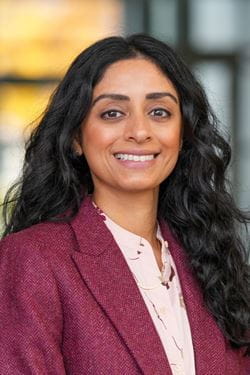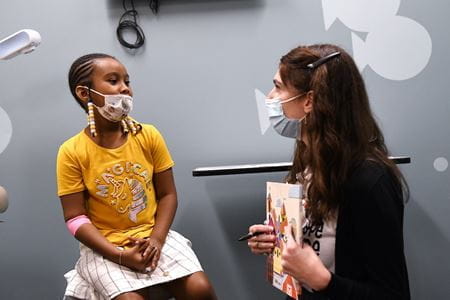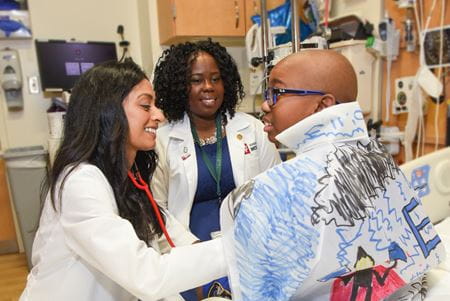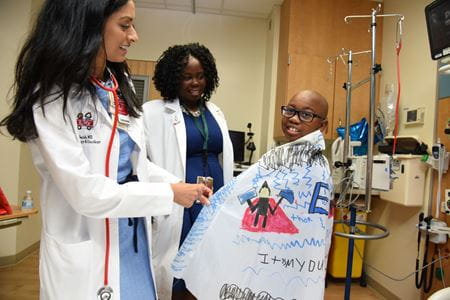Sickle cell disease is the most common inherited blood disorder, affecting up to 100,000 people in the United States. Yet there’s less than $1,000 in research funding per affected individual, noted Seethal Jacob, MD, MS, associate professor of pediatrics at the Indiana University School of Medicine.
“Other genetic conditions get 10 times that amount,” she said.
Jacob is a member of the Health Equity Advancing through Learning health systems Research collaborative known as HEAL-R. In conjunction with National Sickle Cell Awareness Month, she recently gave a presentation on advancing equitable care in sickle cell disease.
Less than 70% of children with the disease receive comprehensive care, Jacob reported. The reasons include socioeconomic factors, access to treatment centers and distrust of medical institutions due to historic racism.
Sickle cell disease primarily affects people of African descent — more than 90% of people with the disease are Black.
In 2022, Jacob contributed to an article published in the Journal of Hospital Medicine, along with IU collaborators Julia LaMotte, PhD, Gerard Hills, MD, and Khajae Henry, MSW, LSW. They asked, “What happens when a healthcare system that was developed by a nation founded on the labor of enslaved individuals intersects with a disease that disproportionately affects communities of color?”
The answer, the evidence shows, is shortened life expectancy and worsened quality of life.
Inequity, by the numbers
Sickle cell disease (SCD) occurs when abnormal hemoglobin causes red blood cells to harden and change shape to look like a sickle tool (banana shape), making it more difficult for these cells to move through blood vessels. Clogs cause severe pain and tissue damage, while low oxygen in the blood can lead to heart, lung and cognition issues.
 Many specialists are needed to effectively manage the disease. The Sickle Cell Program at Riley Children’s Health provides the state’s only hub of experts co-located with subspecialists at a comprehensive children’s hospital. There are no federally funded comprehensive care centers for SCD in the U.S., and Jacob dreams of changing that.
Many specialists are needed to effectively manage the disease. The Sickle Cell Program at Riley Children’s Health provides the state’s only hub of experts co-located with subspecialists at a comprehensive children’s hospital. There are no federally funded comprehensive care centers for SCD in the U.S., and Jacob dreams of changing that.
Comparatively, cystic fibrosis — a genetic disease affecting a much smaller percentage of the U.S. population that is primarily white — has more than 120 accredited treatment centers throughout the nation. Cystic fibrosis also receives more than triple the amount of NIH research dollars per affected person, according to a 2020 study published in JAMA. When private foundation funding is added, cystic fibrosis gets $10,592 in annual funding per affected individual while sickle cell gets $943.
Refining strategies for equitable care
Jacob is an NIH-funded researcher with Children’s Health Services Research at IU School of Medicine and an IU Health clinician who directs the sickle cell program at Riley . IU’s team of pediatric specialists includes pulmonology, neurology, nephrology, psychology, social work and much-needed transition to adult care.
With such comprehensive offerings, Jacob wondered, why weren’t all affected families in Indiana coming for treatment?
“We needed to flip the question,” she determined. “We needed to ask, ‘What are the gaps in what we’re offering?’”
The average sickle cell patient experiences six or more barriers to care. Those include traveling more than an hour to see specialists in Indianapolis and financial difficulties including food and housing insecurity. Four out of five SCD patients rely on public health insurance, and the state’s sickle cell coverage under the Children’s Special Health Care Services program expires at age 18.
 Frequent doctor visits and illness flare-ups mean costly absences from work and school.
These barriers lead to a high “no show” rate for appointments.
Frequent doctor visits and illness flare-ups mean costly absences from work and school.
These barriers lead to a high “no show” rate for appointments.
LaMotte, a pediatric psychologist and assistant professor of clinical pediatrics at IU School of Medicine, created the Sickle Cell Story Club, a grant-supported initiative providing patients with books featuring Black characters. It serves as a reward for showing up to appointments and fosters connection, Jacob said.
LaMotte also has begun incorporating neurocognitive screening into patient visits, as the majority report academic difficulties. More than 44% of sickle cell patients test positive for anxiety or depression.
Adult and adolescent patients often say they’re treated like drug addicts when severe pain sends them to the emergency room asking for relief. Jacob holds close to her heart a quote by Hertz Nazaire, an artist with sickle cell disease who died of its complications at age 48.
“It’s the pain of a broken spirit that hurts more than the physical pain,” Nazaire said in a podcast. “It’s the pain of not being believed at school, at work. It’s the pain of not being believed at the hospital. It’s the pain of the choice to stay at home and suffer, rather than go to a local hospital and be treated like an addict. That’s what breaks you.”
Improving access through telemedicine
Telemedicine is being piloted throughout the state to improve access to care, particularly in rural areas. Remote visits with specialists allow some patients to travel to Indianapolis just once a year instead of quarterly, Jacob said.
At first, patient feedback was mixed. Most liked the convenience and lower transportation costs. But some worried about the lack of physical exams and technology issues.
 The sickle cell team listened and refined the process, building a multidisciplinary team including an SCD coordinator who serves as a navigator and clinical resource. Through the SCD Care Anywhere program, patients go to a local lab for bloodwork, then either visit a local clinic where a nurse takes their vitals and operates telemedicine equipment, or they can use a remote app at home to connect with their hematologist.
The sickle cell team listened and refined the process, building a multidisciplinary team including an SCD coordinator who serves as a navigator and clinical resource. Through the SCD Care Anywhere program, patients go to a local lab for bloodwork, then either visit a local clinic where a nurse takes their vitals and operates telemedicine equipment, or they can use a remote app at home to connect with their hematologist.
When patients do come to Indianapolis for in-person visits, the sickle cell team aims to coordinate services, so everything can be done on the same day. This includes stroke screening and psychological assessments that were frequently missed by patients.
Social workers make reminder calls for appointments and troubleshoot in real time to arrange transportation or alleviate other barriers. The combined team efforts have resulted in a much-improved no-show rate.
“We had a 90 to 100% show rate when patients only had to come to Indy once a year,” Jacob reported. “Families are missing less work and school. Overall, they are satisfied with the care they receive through telemedicine.”
IU’s sickle cell experts will continue to address the gaps and refine their strategies. They won’t be satisfied until they achieve health equity for their sickle cell patients and restore their trust, she said.
